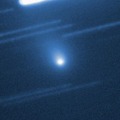
|
Now it is so bright as 8.1 mag (Apr. 27, Marco Goiato). It will approach to the sun down to 0.66 a.u. in July, and it is expected to brighten up to 4-5 mag. Before the perihelion passage, it keeps observable until mid May in the Northern Hemisphere, or until early June in the Southern Hemisphere. After the perihelion passage, it will be observable in excellent condition after late July in the Northern Hemisphere. In the Southern Hemisphere, it keeps unobservable until early September.
Date(TT) R.A. (2000) Decl. Delta r Elong. m1 Best Time(A, h)
Apr. 26 7 47.33 -8 21.5 1.120 1.450 85 8.7 20:12 ( 50, 32)
May 3 7 27.19 -3 23.1 1.220 1.346 73 8.4 20:20 ( 65, 26)
|
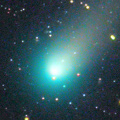
|
It brightened rapidly in outburst in mid October. Now it is bright as 8.5 mag (Apr. 27, Willian Souza). It keeps 8-9 mag until early summer. In the Northern Hemishpere, it keeps observable in the morning sky until July. In the Southern Hemisphere, it keeps observable in good condition for a long time until the comet fades out.
Date(TT) R.A. (2000) Decl. Delta r Elong. m1 Best Time(A, h)
Apr. 26 21 23.32 -9 27.1 1.780 1.810 75 8.4 3:43 (302, 24)
May 3 21 35.42 -11 3.6 1.746 1.854 79 8.5 3:33 (305, 24)
|
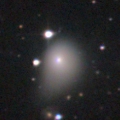
|
Now it is bright as 9.3 mag (Apr. 28, Marco Goiato). The brightening is somewhat slow, but it is expected to brighten up to 6-7 mag in 2014 autumn. It keeps observable in good condition for a long time in the Northern Hemisphere. It keeps locating low in the Southern Hemisphere.
Date(TT) R.A. (2000) Decl. Delta r Elong. m1 Best Time(A, h)
Apr. 26 14 11.60 47 37.1 1.493 2.168 119 9.2 23:50 (180, 77)
May 3 13 25.27 49 20.6 1.472 2.085 113 9.1 22:36 (180, 76)
|
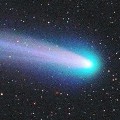
|
It passed only 0.4 A.U. from the earth, and 0.8 A.U. from the sun in November and December, and brightened up to 4.7 mag (Nov. 28, Juan Jose Gonzalez). Now it is 11.3 mag (Apr. 27, Carlos Labordena). It keeps observable until 2014 autumn when the comet fades out.
Date(TT) R.A. (2000) Decl. Delta r Elong. m1 Best Time(A, h)
Apr. 26 17 56.46 -13 21.8 1.465 2.209 125 10.6 3:42 ( 0, 42)
May 3 17 43.08 -15 21.4 1.466 2.299 135 10.7 3:02 ( 0, 40)
|
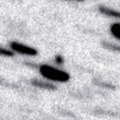
|
The condition in this apparition is bad. It locates low around the brightest days. Now it is not observable. It will appear in the morning sky at 13 mag in late July.
Date(TT) R.A. (2000) Decl. Delta r Elong. m1 Best Time(A, h)
Apr. 26 1 48.42 10 33.5 2.685 1.689 6 12.4 3:43 (245,-15)
May 3 2 8.08 11 55.5 2.667 1.677 8 12.3 3:33 (243,-15)
|
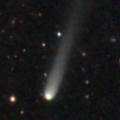
|
Now it is 14.3 mag (Mar. 30, Taras Prystavski). It is expected to brighten up to 7.5 mag and to be observable in excellent condition from summer to autumn in 2014 in the Southern Hemisphere. It keeps observable for a long time in the Southern Hemisphere, although it becomes low temporarily in May. It keeps unobservable for a while in the Northern Hemisphere. It will pass extremely close to Mars in 2014 October.
Date(TT) R.A. (2000) Decl. Delta r Elong. m1 Best Time(A, h)
Apr. 26 2 47.97 -24 10.1 3.526 2.809 38 12.9 20:12 ( 82,-34)
May 3 2 51.08 -23 44.8 3.440 2.737 39 12.8 20:20 ( 87,-40)
|
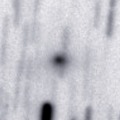
|
It brightened up to 2 mag by unusual major outburst in 2007. It is coming back now. It will be 14 mag at best by normal prediction. But actually, it is already very bright as 13.5 mag (Nov. 25, Hidetaka Sato). Now it is not observable. It will appear in the morning sky in May.
Date(TT) R.A. (2000) Decl. Delta r Elong. m1 Best Time(A, h)
Apr. 26 0 33.97 12 9.6 2.947 2.070 24 13.4 3:43 (255, 0)
May 3 0 48.00 14 16.8 2.924 2.076 26 13.4 3:33 (254, 2)
|

|
It brightened up to 13.1 mag in outburst in March (Mar. 12, Chris Wyatt). Now it is faint as 16.3 mag (Apr. 20, K. Hills).
Date(TT) R.A. (2000) Decl. Delta r Elong. m1 Best Time(A, h)
Apr. 26 15 49.64 -30 56.9 5.243 6.147 151 13.5 1:36 ( 0, 24)
May 3 15 46.49 -30 52.0 5.197 6.145 158 13.5 1:05 ( 0, 24)
|
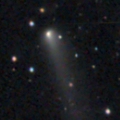
|
Now it is 12.9 mag (Mar. 28, Sandor Szabo). It will brighten up to 13 mag and to be observable in excellent condition from spring to summer.
Date(TT) R.A. (2000) Decl. Delta r Elong. m1 Best Time(A, h)
Apr. 26 13 58.99 -10 42.3 1.575 2.580 175 13.7 23:41 ( 0, 44)
May 3 13 55.89 -10 9.6 1.581 2.576 168 13.7 23:10 ( 0, 45)
|
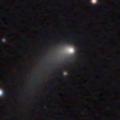
|
Now it is 13.7 mag (Apr. 18, Taras Prystavski). It keeps 14 mag for a long time until 2014 summer. It keeps observable in good condition in the Northern Hemisphere. It keeps unobservable after this in the Southern Hemisphere.
Date(TT) R.A. (2000) Decl. Delta r Elong. m1 Best Time(A, h)
Apr. 26 4 6.32 54 3.6 2.187 1.662 46 13.9 20:12 (140, 25)
May 3 4 27.17 56 53.0 2.201 1.668 46 13.9 20:20 (144, 24)
|

|
It brightened up to 11-12 mag in 2012. Now it is 13.7 mag (Mar. 28, Sandor Szabo). It will be observable in good condition at 14 mag until 2014 early summer.
Date(TT) R.A. (2000) Decl. Delta r Elong. m1 Best Time(A, h)
Apr. 26 12 15.50 -9 44.4 6.565 7.461 151 14.0 21:58 ( 0, 45)
May 3 12 10.64 -9 14.2 6.665 7.496 143 14.0 21:25 ( 0, 46)
|
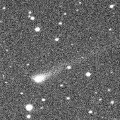
|
Now it is 15.2 mag (Apr. 7, Katsumi Yoshimoto). It keeps bright as 13-14 mag for a long time from 2013 to 2014.
Date(TT) R.A. (2000) Decl. Delta r Elong. m1 Best Time(A, h)
Apr. 26 20 44.09 -25 14.0 2.911 3.060 88 14.1 3:43 (321, 18)
May 3 20 50.58 -25 13.5 2.820 3.062 94 14.0 3:33 (323, 20)
|
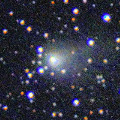
|
First return of a new periodic comet discovered in 1998. It brightened up to 10 mag at the discovery. Now it is 12.7 mag (Mar. 28, Sandor Szabo). A bit fainter than originally expected. But in the Northern Hemisphere, it keeps observable in excellent condition from autumn to spring. It locates somewhat low in the Southern Hemisphere.
Date(TT) R.A. (2000) Decl. Delta r Elong. m1 Best Time(A, h)
Apr. 26 7 39.08 15 25.7 2.163 2.197 78 14.0 20:12 ( 74, 47)
May 3 7 51.11 14 16.2 2.248 2.210 74 14.1 20:20 ( 77, 42)
|
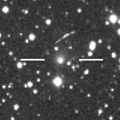
|
Brightened rapidly. Now it is 14.0 mag (Mar. 28, Sandor Szabo). It will brighten up to 13-14 mag and will be observable in excellent condition from spring to summer in the Southern Hemisphere. It locates somewhat low in the Northern Hemispehre.
Date(TT) R.A. (2000) Decl. Delta r Elong. m1 Best Time(A, h)
Apr. 26 8 28.87 -18 50.3 1.606 2.010 97 14.1 20:12 ( 33, 29)
May 3 8 41.00 -18 2.1 1.624 1.987 95 14.0 20:20 ( 39, 27)
|

|
Now it is 14.0 mag (Mar. 29, Sandor Szabo). It keeps bright at 13-14 mag for a long time until 2014.
Date(TT) R.A. (2000) Decl. Delta r Elong. m1 Best Time(A, h)
Apr. 26 19 54.77 4 14.4 6.230 6.369 93 14.0 3:43 (312, 49)
May 3 19 52.56 4 8.4 6.133 6.388 100 14.0 3:33 (318, 52)
|
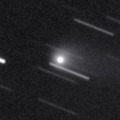
|
Now it is bright as 13.9 mag (Mar. 29, Sandor Szabo). It keeps 13-14 mag and observable in good condition in the Northern Hemisphere for a long time from 2013 to 2014. In the Southern Hemisphere, it is not observable until 2014 autumn.
Date(TT) R.A. (2000) Decl. Delta r Elong. m1 Best Time(A, h)
Apr. 26 1 0.27 51 56.0 4.317 3.622 41 14.6 3:43 (219, 18)
May 3 1 5.17 51 47.2 4.345 3.642 40 14.6 3:33 (220, 20)
|

|
Big asteroid discovered in 1906. It suddenly showed the cometary activity on Dec. 11, 2010, probably due to an impact of a small object. It has already turned to be stellar.
Date(TT) R.A. (2000) Decl. Delta r Elong. m1 Best Time(A, h)
Apr. 26 2 25.89 7 46.2 4.319 3.321 6 14.9 20:12 (115,-20)
May 3 2 34.78 8 41.1 4.325 3.327 6 14.9 3:33 (241,-22)
|
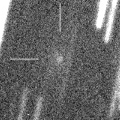
|
Now it is 17.4 mag (Apr. 13, Hidetaka Sato). It brightened up to 9 mag at the discovery in 2005. It will approach to the sun down to 0.8 a.u. on May 29. However, it will brighten up to 14 mag at best. In this apparition, it keeps observable in the morning sky all through the period. But it locates extremely low around the perihelion passage in the Northern Hemisphere.
Date(TT) R.A. (2000) Decl. Delta r Elong. m1 Best Time(A, h)
Apr. 26 22 18.42 -9 28.8 0.863 0.977 62 15.4 3:43 (293, 14)
May 3 23 1.04 -6 19.5 0.877 0.925 58 14.9 3:33 (286, 12)
|
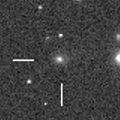
|
It is expected to brighten up to 13 mag and to be observable in good condition in 2015. Now it is 14.6 mag (Apr. 22, Taras Prystavski). In 2014, it will be observable at 15 mag in good condition from winter to summer.
Date(TT) R.A. (2000) Decl. Delta r Elong. m1 Best Time(A, h)
Apr. 26 13 46.83 -0 29.8 3.668 4.649 165 15.0 23:29 ( 0, 54)
May 3 13 44.02 -0 6.3 3.652 4.609 159 14.9 22:58 ( 0, 55)
|
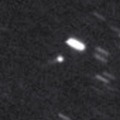
|
Now it is 16.1 mag (Apr. 15, Taras Prystavski). It will approach to the earth down to 0.06 a.u. from May to June, and it is expected to brighten up to 11 mag. In the Northern Hemisphere, it keeps observable in excellent condition until the highlight in late May while the comet will be brightening rapidly. In the Southern Hemisphere, it is not observable now. But it will be observable in mid May. Then it keeps observable in excellent condition at the highlight and after that while the comet will be fading.
Date(TT) R.A. (2000) Decl. Delta r Elong. m1 Best Time(A, h)
Apr. 26 7 59.24 69 54.1 0.316 0.981 76 15.5 20:12 (161, 50)
May 3 8 25.37 67 50.2 0.256 0.971 74 15.0 20:20 (158, 50)
|
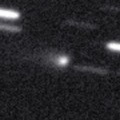
|
Now it is 14.9 mag (Apr. 18, Taras Prystavski). It is expected to brighten up to 5 mag in 2014 autumn. It will be unobservable soon. It will be observable again in July in the Southern Hemisphere, or in August in the Northern Hemisphere.
Date(TT) R.A. (2000) Decl. Delta r Elong. m1 Best Time(A, h)
Apr. 26 4 52.69 18 26.8 3.399 2.688 38 15.5 20:12 (102, 15)
May 3 4 54.96 18 17.1 3.390 2.597 32 15.3 20:20 (106, 8)
|
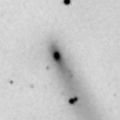
|
Now it is 15.2 mag (Apr. 22, Taras Prystavski), brighter than origianlly predicted. It will be observable at 14-16 mag for a long time from 2013 to 2014.
Date(TT) R.A. (2000) Decl. Delta r Elong. m1 Best Time(A, h)
Apr. 26 16 16.20 -25 12.5 3.229 4.122 148 15.7 2:02 ( 0, 30)
May 3 16 12.93 -25 16.9 3.195 4.136 156 15.7 1:31 ( 0, 30)
|
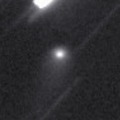
|
It brightened up to 14.0 mag from spring to summer in 2013 (June 11, Sandor Szabo). Now it is 15.7 mag, much brighter than origianlly predicted (Apr. 24, Taras Prystavski). In the Northern Hemisphere, it will be observable at 15-16 mag in excellent condition until spring. It locates somewhat low in the Southern Hemisphere.
Date(TT) R.A. (2000) Decl. Delta r Elong. m1 Best Time(A, h)
Apr. 26 12 0.12 35 24.4 3.947 4.561 122 16.2 21:42 (180, 90)
May 3 11 52.10 35 56.9 4.084 4.602 115 16.4 21:07 (180, 89)
|
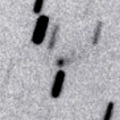
|
Brightening rapidly. Now it is 15.7 mag (Apr. 22, Taras Prystavski). It will start fading after June, and will be fainter than 18 mag in August.
Date(TT) R.A. (2000) Decl. Delta r Elong. m1 Best Time(A, h)
Apr. 26 14 14.26 -11 19.8 1.145 2.150 177 16.3 0:01 ( 0, 44)
May 3 14 7.51 -12 10.6 1.144 2.146 171 16.3 23:22 ( 0, 43)
|
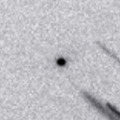
|
It approached to the earth down to 0.68 a.u. in spring, and brightened up to 15.6 mag (Mar. 29, Taras Prystavski). Now it is fading. It has already faded down to 16.8 mag (Apr. 23, E. Arce). It will be fainter than 18 mag in June.
Date(TT) R.A. (2000) Decl. Delta r Elong. m1 Best Time(A, h)
Apr. 26 10 33.92 -5 16.2 0.851 1.653 125 16.5 20:17 ( 0, 49)
May 3 10 33.43 -8 21.8 0.912 1.660 119 16.7 20:20 ( 11, 46)
|
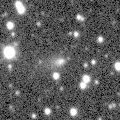
|
It brightened up to 14.7 mag in winter (Jan. 19, Taras Prystavski). Now it is fading. It has already faded down to 16.4 mag (Apr. 20, Taras Prystavski). It will be fainter than 18 mag in June.
Date(TT) R.A. (2000) Decl. Delta r Elong. m1 Best Time(A, h)
Apr. 26 7 27.50 24 38.8 1.828 1.834 74 16.6 20:12 ( 88, 50)
May 3 7 44.78 23 20.7 1.903 1.851 71 16.7 20:20 ( 89, 45)
|
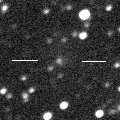
|
Now it is 17.9 mag (Mar. 9, W. Hasubick). Distant object, but it keeps observable at 14 mag for a long time from 2015 to 2016.
Date(TT) R.A. (2000) Decl. Delta r Elong. m1 Best Time(A, h)
Apr. 26 19 20.42 -3 12.3 6.898 7.199 103 16.8 3:43 (329, 47)
May 3 19 20.94 -2 56.1 6.763 7.166 109 16.7 3:33 (335, 49)
|
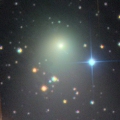
|
It became much brighter than expected, and reached up to 8.5 mag (Aug. 15, Alexandre Amorim). Now it is fading rapidly. It has already faded down to 16.3 mag (Mar. 30, Taras Prystavski). In the Southern Hemisphere, it will keep observable in good condition for a long time until 2014 summer when the comet fades out. It will never be observable again in the Northern Hemisphere.
Date(TT) R.A. (2000) Decl. Delta r Elong. m1 Best Time(A, h)
Apr. 26 16 4.97 -71 17.9 2.901 3.509 119 16.8 1:52 ( 0,-16)
May 3 15 46.18 -70 33.6 2.916 3.579 124 17.0 1:06 ( 0,-16)
|

|
Now it is 16.5 mag (Apr. 16, Taras Prystavski). It keeps 17 mag for a long time from 2014 to 2015. It is observable in excellent condition in the Northern Hemisphere. It is observable only until 2014 summer in the Southern Hemisphere.
Date(TT) R.A. (2000) Decl. Delta r Elong. m1 Best Time(A, h)
Apr. 26 16 12.97 26 0.4 3.510 4.238 130 17.0 1:59 ( 0, 81)
May 3 16 9.89 27 44.4 3.477 4.213 131 17.0 1:28 ( 0, 83)
|
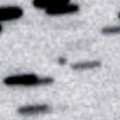
|
Now it is 17.0 mag (Apr. 5, J. F. Hernandez). It keeps 17-18 mag for a long time from 2014 to 2016.
Date(TT) R.A. (2000) Decl. Delta r Elong. m1 Best Time(A, h)
Apr. 26 14 31.23 -12 17.8 4.680 5.684 175 17.1 0:18 ( 0, 43)
May 3 14 22.19 -12 2.9 4.662 5.666 174 17.1 23:36 ( 0, 43)
|

|
Now it is 17.5 mag (Apr. 5, N. James). It keeps observable at 18 mag for a long time from 2013 to 2016. It keeps locating high in the Northern Hemisphere. It keeps locating very low in the Southern Hemipshere.
Date(TT) R.A. (2000) Decl. Delta r Elong. m1 Best Time(A, h)
Apr. 26 19 8.47 41 52.9 6.385 6.510 92 17.2 3:43 (238, 75)
May 3 19 4.43 43 15.8 6.327 6.505 95 17.1 3:33 (225, 77)
|
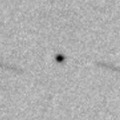
|
It is expected to brighten up to 4-5 mag from autumn to winter in 2015. It is appearing in the morning sky in the Southern Hemisphere. It is not observable until late May in the Northern Hemisphere. It is observable in good condition in the Southern Hemisphere until the highlight, or in the Northern Hemisphere after the highlight.
Date(TT) R.A. (2000) Decl. Delta r Elong. m1 Best Time(A, h)
Apr. 26 23 52.34 -11 22.7 7.533 6.828 42 17.2 3:43 (280, -5)
May 3 23 54.74 -11 19.5 7.388 6.767 48 17.1 3:33 (282, -2)
|
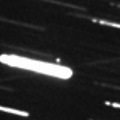
|
Now it is 18.2 mag (Apr. 22, D. Herald). It keeps 17-18 mag for a long time from 2013 to 2014. It is observable in excellent condition in the Southern Hemisphere. It is not observable in the Northern Hemisphere.
Date(TT) R.A. (2000) Decl. Delta r Elong. m1 Best Time(A, h)
Apr. 26 12 4.82 -58 49.6 3.992 4.687 128 17.2 21:46 ( 0, -4)
May 3 11 48.05 -58 8.6 4.017 4.691 126 17.2 21:02 ( 0, -3)
|
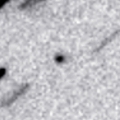
|
It was observed at 17.5 mag in early 2013. It will be observable at 17.5 mag again from spring to summer in 2014.
Date(TT) R.A. (2000) Decl. Delta r Elong. m1 Best Time(A, h)
Apr. 26 19 34.87 -12 51.4 2.404 2.792 101 17.4 3:43 (330, 37)
May 3 19 38.96 -12 42.0 2.332 2.807 107 17.3 3:33 (334, 38)
|
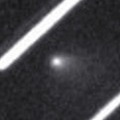
|
It brightened up to 15.1 mag at opposition in March (Mar. 11, Catalina Sky Survey). Now it is fading rapidly. It has already faded down to 17.4 mag (Apr. 18, K. Hills). It will be fainter than 18 mag in May.
Date(TT) R.A. (2000) Decl. Delta r Elong. m1 Best Time(A, h)
Apr. 26 10 34.74 31 21.2 1.655 2.226 111 17.6 20:16 ( 0, 86)
May 3 10 18.57 32 15.0 1.846 2.273 101 17.9 20:20 ( 78, 80)
|
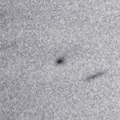
|
Now it is 17.9 mag (Apr. 6, Ken-ichi Kadota). It keeps 17 mag for a long time until 2015.
Date(TT) R.A. (2000) Decl. Delta r Elong. m1 Best Time(A, h)
Apr. 26 10 46.30 -6 30.5 2.764 3.484 128 17.6 20:29 ( 0, 48)
May 3 10 46.19 -6 7.7 2.827 3.470 122 17.7 20:20 ( 7, 49)
|
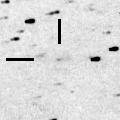
|
Now it is 17.1 mag (Apr. 14, A. Maury, J.-G. Bosch, T. Noel, J.-F. Soulier). It keeps 17-18 mag until June.
Date(TT) R.A. (2000) Decl. Delta r Elong. m1 Best Time(A, h)
Apr. 26 18 42.89 -19 7.2 1.364 2.012 115 17.7 3:43 (347, 35)
May 3 18 45.52 -18 53.3 1.327 2.042 121 17.7 3:33 (351, 36)
|

|
First return of a new periodic comet which brightened up to 13 mag in 2007. It was expected to brighten up to 13 mag again and observable in good condition from summer to autumn in 2014. But actually, it is 18.3 mag, much fainter than expected (Apr. 2, Taras Prystavski). It will be 16 mag at best actually.
Date(TT) R.A. (2000) Decl. Delta r Elong. m1 Best Time(A, h)
Apr. 26 21 57.89 -8 46.9 2.667 2.456 67 18.0 3:43 (296, 19)
May 3 22 9.03 -8 3.6 2.574 2.439 70 17.9 3:33 (296, 20)
|
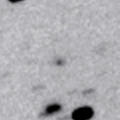
|
Now it is 18.1 mag (Mar. 29, M. Jaeger, W. Vollmann, E. Prosperi, S. Prosperi). It keeps 18 mag for a very long time from 2013 to 2018. It locates high in the Southern Hemisphere. But it locates somewhat low in the Northern Hemisphere.
Date(TT) R.A. (2000) Decl. Delta r Elong. m1 Best Time(A, h)
Apr. 26 10 56.14 -17 6.7 8.602 9.311 132 17.9 20:39 ( 0, 38)
May 3 10 55.61 -16 47.5 8.672 9.306 126 17.9 20:20 ( 3, 38)
|
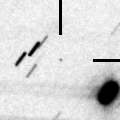
|
Now it is 17.6 mag (Mar. 28, A. Maury, J.-F. Soulier, T. Noel, J.-G. Bosch). It keeps 18 mag from spring to summer. It is observable in good condition in the Southern Hemisphere. It is not observable in the Northern Hemisphere.
Date(TT) R.A. (2000) Decl. Delta r Elong. m1 Best Time(A, h)
Apr. 26 17 16.54 -66 25.6 0.652 1.438 118 17.9 3:03 ( 0,-11)
May 3 17 17.27 -66 23.4 0.658 1.473 122 17.9 2:36 ( 0,-11)
|
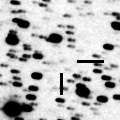
|
Now it is 18.5 mag (Mar. 31, Hidetaka Sato). It is observable at 18 mag in good condition from spring to summer.
Date(TT) R.A. (2000) Decl. Delta r Elong. m1 Best Time(A, h)
Apr. 26 20 44.31 -10 8.0 1.699 1.894 84 17.9 3:43 (311, 30)
May 3 20 53.48 -7 37.3 1.646 1.911 88 17.9 3:33 (311, 33)
|

|
Now it is 18.1 mag (Apr. 20, Catalina Sky Survey). It keeps 18 mag for a long time from 2013 to 2014.
Date(TT) R.A. (2000) Decl. Delta r Elong. m1 Best Time(A, h)
Apr. 26 16 9.62 15 48.0 6.734 7.522 138 17.9 1:55 ( 0, 71)
May 3 16 4.68 16 39.0 6.709 7.525 141 17.9 1:23 ( 0, 72)
|

|
First return of a new periodic comet discovered in 2005. It was expected to be observable at 17 mag for a long time from 2013 to 2014. However, it has not been recovered yet. Actually, it is much fainter than predicted, fainter than 20 mag (Aug. 6, Jean-Francois Soulier).
Date(TT) R.A. (2000) Decl. Delta r Elong. m1 Best Time(A, h)
Apr. 26 22 19.72 -10 14.6 3.569 3.229 62 17.9 3:43 (293, 14)
May 3 22 27.31 -9 41.1 3.487 3.235 67 17.9 3:33 (294, 16)
|
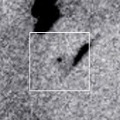
|
Now it is 19.4 mag (Apr. 4, A. Waszczak). First return of a new periodic comet which brightened up to 13 mag in outburst in 2008. It will be observable in good condition from spring to summer. However, it will be only 19-20 mag at best in this apparition.
Date(TT) R.A. (2000) Decl. Delta r Elong. m1 Best Time(A, h)
Apr. 26 12 13.65 15 44.3 1.629 2.475 138 19.5 21:56 ( 0, 71)
May 3 12 11.35 15 24.9 1.669 2.462 132 19.5 21:26 ( 0, 70)
|
|
![]()
 C/2013 C2 ( Tenagra )
C/2013 C2 ( Tenagra ) 294P/2013 X2 ( LINEAR )
294P/2013 X2 ( LINEAR ) 296P/2014 A1 ( Garradd )
296P/2014 A1 ( Garradd ) C/2013 H2 ( Boattini )
C/2013 H2 ( Boattini ) P/2005 L1 ( McNaught )
P/2005 L1 ( McNaught ) 297P/2014 D1 ( Beshore )
297P/2014 D1 ( Beshore )![]()










































